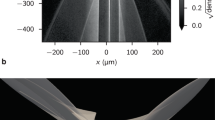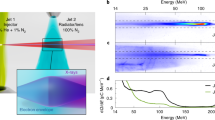Abstract
A GAS lens is capable of focusing light if the temperature, and therefore refractive index, of a gas is made to vary across an optical aperture in a suitable manner. Practical applications of gas lenses were pursued thirty years ago1,2 in the context of power transmission by laser beams, but little work has been done since then. It was recently shown, however, that a gas lens can focus a laser beam well enough to drill holes in a metal sheet3, and it has been argued4 that gas lenses are 'varifocal' devices with negligible dispersion from ultraviolet to infrared wavelengths, and that they may be able to transmit and focus more powerful laser beams than conventional lenses can cope with. They may therefore find some application in laser-driven thermonuclear experiments5. Here we describe another application of gas lenses: telescopy. We have constructed a simple gas lens telescope, and have used it to make images of the Sun and the Moon.
This is a preview of subscription content, access via your institution
Access options
Subscribe to this journal
Receive 51 print issues and online access
$199.00 per year
only $3.90 per issue
Buy this article
- Purchase on Springer Link
- Instant access to full article PDF
Prices may be subject to local taxes which are calculated during checkout
Similar content being viewed by others
References
Marcuse, D. Light Transmission Optics; (Van Nostrand Reinhold, New York, 1982).
Gloge, D. Bell Systems Tech. J. 47, 179–194 (1968).
Michaelis, M. M., Notcutt, M. & Cunningham, P. F. Opt. Commun. 59, 369–374 (1986).
Xie, B. L., Xia, S.-J. & Chow, W.-T. Chinese Phys. Lett 2, 509–512 (1985).
Michaelis, M. M., Cunningham, P. F., Cazalet, R. S., Waltham, J. A. & Notcutt, M. Laser Particle Beams 9, 641–651 (1991).
Notcutt, M. thesis, Univ. of Natal. (1989).
Aoki, Y. & Suzuki, M. IEEE Trans. Microwave Theory Techn. MTT-15, 2–8 (1967).
Notcutt, M., Michaelis, M. M., Cunningham, P. F., Cazalet, R. S. & Waltham, J. A. Opt. Laser Technol. 20, 243–250 (1988).
Notcutt, M., Waltham, J. A., Michaelis, M. M., Cunningham, P. F. & Cazalet, R. S. Appl. Opt. 28, 2464–2465 (1989).
Cazalet, R. S., Cunningham, P. F., Michaelis, M. M., Notcutt, M. & Waltham, J. A. Measurement Sci. Technol. 1, 147–150 (1990).
Brown, R. A. & Ford, H. C. Report of the HST Strategy Panel (Space Telescope Science Institute, Baltimore, 1991).
Kare, J. T. (ed.) Proc. SDIO Workshop on Laser Propulsion., Los Alamos, 1987 (ed. Kare, J. T.) (Technical Information Department, Lawrence Livermore National Laboratory, 1990).
Author information
Authors and Affiliations
Rights and permissions
About this article
Cite this article
Michaelis, M., Dempers, C., Kosch, M. et al. A gas-lens telescope. Nature 353, 547–548 (1991). https://doi.org/10.1038/353547a0
Received:
Accepted:
Issue Date:
DOI: https://doi.org/10.1038/353547a0
This article is cited by
-
Acousto-optic modulation of gigawatt-scale laser pulses in ambient air
Nature Photonics (2024)
-
Ultra high damage threshold optics for high power lasers
Communications Physics (2020)
-
Focusing light with a flame lens
Nature Communications (2013)
-
Photonics in South Africa
Nature Photonics (2007)
Comments
By submitting a comment you agree to abide by our Terms and Community Guidelines. If you find something abusive or that does not comply with our terms or guidelines please flag it as inappropriate.



